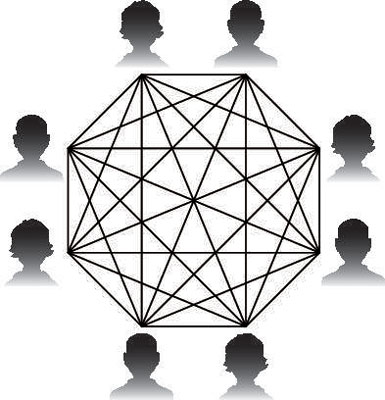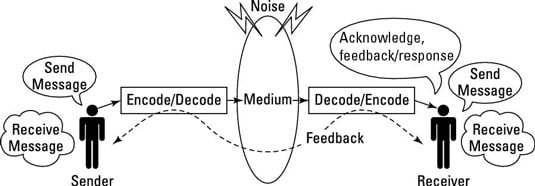Getting the word out effectively means analyzing your audience and your environment. Additionally, for the PMP Certification Exam, you want to select the most effective method of communication for your project.
Communication requirements analysis
As you review the stakeholder management register, compare it against your organization’s infrastructure and assets to help determine the best communication approach. You might also want to look at your project and the company organization charts. Analyze what information is internal and what information needs to go outside the organization. Also consider whether stakeholders are in one location or many locations.
The more people you communicate with, the more opportunity there is for miscommunication. A mathematical model shows the relationship between the number of people and the number of communication channels (or paths):
(N (n – 1)) / 2
where n is the number of people.
See how this plays out. If you have five people, here’s how to calculate the number of communication channels you have:
(5 (5 – 1)) / 2 = 10

Now see what happens when you add three more people. You might think you have three more channels, or even six more channels. However, you actually have 18 more communication channels!

The equation is now
(8 (8 – 1)) / 2 = 28
Think about it this way: There are 28 ways for people to interpret the information — and that means 28 ways for your message to get misinterpreted. Add another four people to the team, and that number increases to 66! Communication has to be effective and efficient!
Technology
The technology you have available is one of those enterprise environmental factors (EEFs) you have to take into consideration, especially if you have a team with internal team members and external contractors. Also, consider whether people are centrally located or geographically dispersed. Here are some technology factors that will shape your communication plan.
Urgency: Determine whether stakeholders need information immediately or can wait. If you are working on a construction project in a hazardous environment, such as an area prone to hurricanes or tornadoes, you need the ability to communicate immediately with the construction site and the workers who could be impacted.
Technology availability: Assess whether your organization has the technology and systems in place to support your communication strategy. A project that requires some of the staff to work remotely for several days would require the staff to have laptops. If they are normally in the office full time and have only desktop computers, consider the matter upfront.
Ease of use: You can set up a really cool website to communicate with your team. It might have document storage, messaging capability, version control, and all sorts of neat functionality, but if it’s not intuitive to the audience and easy to use, no one is going to use it. When it comes to communication, remember: Keep it simple!
Expected staffing: Check that everyone has the same platform or the same access to information. This is particularly relevant when working with contractors, who might work on a very different technology platform. For example, say you hire a marketing firm for part of your project; that firm uses Apple computers, but your firm uses PCs. Staffing your project with members from the marketing firm impacts project communication.
Duration: For projects that are three years or longer, you can count on at least some of your communications technology changing. You might not know how it will change, but it would be wise to keep that in mind. With smartphones and tablet computers rapidly evolving with new applications, predicting how people will communicate in the future is difficult!
Project environment: The environment can be as simple as part of the team being virtual, or it can include more complex factors such as team members located in different time zones, countries, or even extreme geographic locations, such as in the Arctic Circle or the Mojave Desert.
Communication models
The PMP exam uses a standard sender-receiver communication model.

Sender: Who conveys a message and is responsible for making the content clear and complete. The sender is also responsible for confirming that the receiver understands the message correctly.
Encoding: Translating ideas into language, usually written or verbal language.
Message: The output of encoding.
Medium: The means of conveying the message. Sometimes the medium is referred to as the channel.
Noise: Anything that interferes with the transmission of the message, including static, distractions, preconceptions and stereotypes, cultural norms, malfunctioning transmitting equipment, or anything that deteriorates or causes a barrier to successful transmission.
Decoding: Translating the message into meaningful thoughts and ideas.
Receiver: The recipient of the message, responsible for decoding the message and providing feedback. The receiver is responsible for making sure that the entire message is received and understood by encoding a message back to the sender conveying that.
Acknowledge: Confirming receipt of the information. Acknowledging receipt does not imply agreement, but only receipt.
Feedback/response: After the communication has been received and understood, the receiver may send a message with thoughts and ideas about the message.
Communication methods
Communication methods include push, pull, and interactive communication:
Push: Communication sent to receivers, comprising a sender, medium, and message. It does not necessarily reach the receiver for decoding. This includes memos, e-mails, reports, voice mail, and so forth.
Pull: Information sought by the receiver. In other words, the receiver actively searches for the information. This can include a team member going to an intranet to find communication policies or templates, running Internet searches, and using online repositories.
Interactive: Sender and receiver exchanging information. This occurs in conversation, phone calls, meetings, and the like. This is the most effective form of communication.
The most common form of interactive communication is meetings. Teams have meetings to plan, communicate status, problem-solve, make decisions, collect lessons learned, and for a variety of other reasons.

